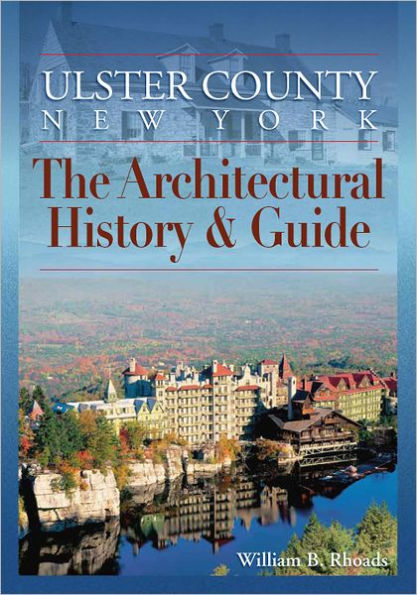
Ulster County, New York: The Architectural History & Guide
376
Ulster County, New York: The Architectural History & Guide
376Paperback
-
PICK UP IN STORECheck Availability at Nearby Stores
Available within 2 business hours
Related collections and offers
Overview
Illustrated with 350 archival and contemporary photographs, drawings, paintings, and maps, the 325 sites author William B. Rhoads explores in "Ulster County, New York" display the variety and changing architectural styles that have appeared over nearly 400 years in the Hudson River Valley and Catskill Mountains, from 17th-century Dutch limestone houses of the colonial era, through the Federal and Victorian periods, up to the Modernist architecture of the mid-1950s.
The architecture reflects the history, tracing the evolution of one of the first regions in today's New York State to be settled by Europeans. Dutch and French Huguenot villages and homesteads of the 1600s form the core of today's Kingston and New Paltz, surrounded by the structures built by their descendants and later immigrants—the English, Irish, Italians, and scores of other ethnic and national groups—as Ulster County rose from the ashes of the American Revolution and became an important commercial center, with bustling ports on the Hudson River, the booming 19th-century "Empire State's" first superhighway.
Everywhere one looks in Ulster County there are vestiges of the past—abandoned brickyards, locks of the old D&H Canal, idle railroad depots, the ghostly shell of a grand old hotel that never opened to the public. And there is the "living history" as well, the structures built by previous generations that are still vital today, like the Mohonk Mountain House and the hundreds of other historic buildings representing nearly every American architectural style from 1660 to 1950 that remain private homes, libraries, schools, houses of worship, or have been converted into museums.
Grand mountain hotels and baronial hunting lodges are represented in Ulster County, New York, but so also are the modest homes of the poor and the middle class. Author Rhoads's concept of architectural heritage is broad and all-encompassing. There are bridges and cemeteries, a "school-bus house" and a vacation resort composed largely of retired Kingston trolley cars. There are rotting huckleberry pickers' shacks, the bizarre but creative cabins of hermits and eccentrics, side by side some of America's most influential art colonies, "Gilded Age" mansions, and dozens of buildings on the National Register including the wonderfully intact National Historic Landmark District in New Paltz and the stately National Register Historic District of Cragsmoor.
The text is enlivened with the histories of the owners, the architects and the builders, as well as the social and historical context within which the structures were built. Ulster County, New York is a monumental work, the culmination of the author's lifetime study of the Hudson Valley's cultural history.

Product Details
| ISBN-13: | 9781883789701 |
|---|---|
| Publisher: | Black Dome Press, Corporation |
| Publication date: | 11/08/2011 |
| Pages: | 376 |
| Sales rank: | 1,107,426 |
| Product dimensions: | 6.90(w) x 9.90(h) x 1.00(d) |
About the Author
William B. Rhoads is a professor emeritus of art history at SUNY New Paltz, where he taught from 1970 to 2005. His publications include studies of Colonial Revival architecture and Franklin Roosevelt's sponsorship of architecture and art. Rhoads's "Kingston, New York: The Architectural History & Guide" was published by Black Dome Press in 2003.
What People are Saying About This
In a world roiled by constant motion, and dislocation, and hardship, our fond places can provide a longed-for sense of steadiness, and contentment. Professor Rhoads's careful work affords us this perception. ... The book in your hand will serve as a most excellent guide, and for the armchair browsing the author recommends, a rich history. It is a meticulous, thoughtful and charming account of the structures of Ulster County—of the Empire State's sixty-two counties one of the most historic and bountiful. (Joan K. Davidson, President, Furthermore: a program of the J.M. Kaplan Fund, and former Commissioner of NYS Office of Parks, Recreation and Historic Preservation)
Equally suited to armchair or passenger seat, William Rhoads's guide serves to enchant and inform readers and adventurers alike. This comprehensive review of Ulster County's architecture from the colonial era through the 1950s runs the gamut from diners and drive-ins to country estates and riverfront monasteries. With extensive details about owners and builders as well as architectural styles and significance, it also gives the reader a glimpse into the county's social history. This is a guide that surpasses the traditional necessities 'where' and 'what' and arrives at the 'why' of these treasures. (Christopher Pryslopski, Associate Editor, The Hudson River Valley Review)
Truly a tour de force for the touring (or armchair) fan of architecture and regional history, this book presents, town by town, the extraordinary quality and diversity of a county's built environment. Professor Rhoads provides a notable public service in bringing into focus a glorious gallimaufry of landmarks, from settler's stone cottage to tycoon's mansion and wilderness camp, from river lighthouse to one-room school, from castle-like prison and vast waterworks to sumptuous church and art colony, from cast-iron storefront to modernist glass house. Prodigiously researched and richly illustrated, the brief entries are nevertheless written with a light touch; through the often colorful snapshots of builders and architects and what they wrought, we view the evolution of building types and styles and indeed the whole economic and social development of a region. (John Winthrop Aldrich, former NYS Deputy Commissioner for Historic Preservation)
